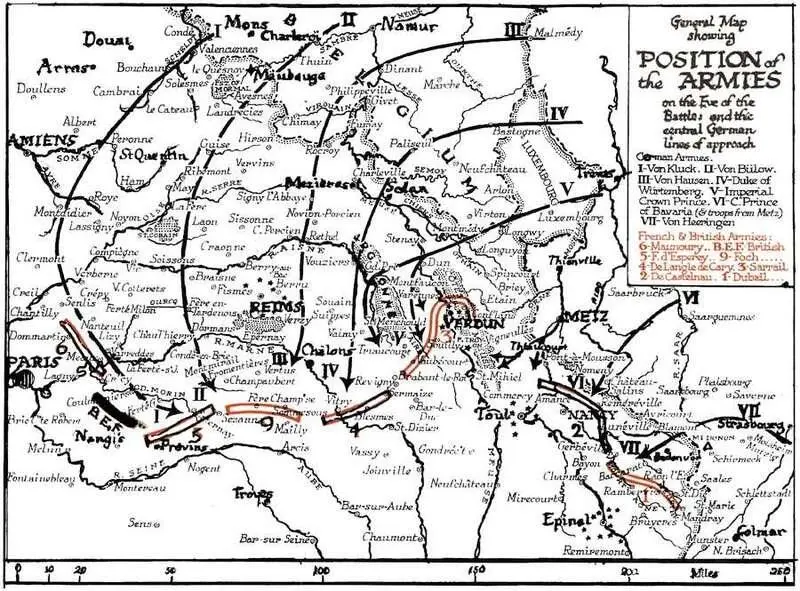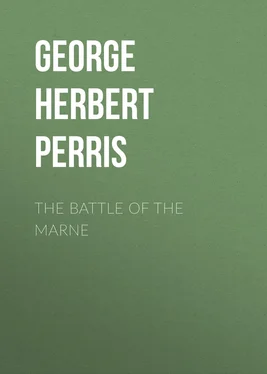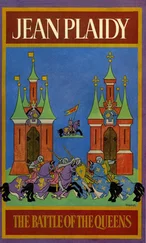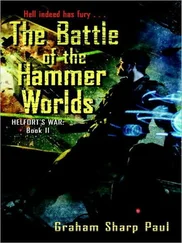George Herbert Perris - The Battle of the Marne
Здесь есть возможность читать онлайн «George Herbert Perris - The Battle of the Marne» — ознакомительный отрывок электронной книги совершенно бесплатно, а после прочтения отрывка купить полную версию. В некоторых случаях можно слушать аудио, скачать через торрент в формате fb2 и присутствует краткое содержание. Жанр: foreign_prose, foreign_antique, на английском языке. Описание произведения, (предисловие) а так же отзывы посетителей доступны на портале библиотеки ЛибКат.
- Название:The Battle of the Marne
- Автор:
- Жанр:
- Год:неизвестен
- ISBN:нет данных
- Рейтинг книги:5 / 5. Голосов: 1
-
Избранное:Добавить в избранное
- Отзывы:
-
Ваша оценка:
- 100
- 1
- 2
- 3
- 4
- 5
The Battle of the Marne: краткое содержание, описание и аннотация
Предлагаем к чтению аннотацию, описание, краткое содержание или предисловие (зависит от того, что написал сам автор книги «The Battle of the Marne»). Если вы не нашли необходимую информацию о книге — напишите в комментариях, мы постараемся отыскать её.
The Battle of the Marne — читать онлайн ознакомительный отрывок
Ниже представлен текст книги, разбитый по страницам. Система сохранения места последней прочитанной страницы, позволяет с удобством читать онлайн бесплатно книгу «The Battle of the Marne», без необходимости каждый раз заново искать на чём Вы остановились. Поставьте закладку, и сможете в любой момент перейти на страницу, на которой закончили чтение.
Интервал:
Закладка:
George Herbert Perris
The Battle of the Marne

General Map showing
POSITION of the ARMIES on the Eve of the Battle, and the central German lines of approach.
German Armies.
I–Von Kluck. II–Von Bülow. III–Von Hausen. IV–Duke of Würtemberg. V–Imperial Crown Prince. VI–C. Prince of Bavaria (& troops from Metz). VII–Von Heeringen.
French & British Armies:
6–Marmoury. B.E.F.British.
5–F. d’Espérey. 9–Foch.
4–DeLangle de Cary. 3–Sarrail.
2–DeCastelnau. 1–Dubail.
PREFACE
The great war has entered into history. The restraints, direct and indirect, which it imposed being gone with it, we return to sounder tests of what should be public knowledge—uncomfortable truths may be told, secret places explored. At the same time, the first squall of controversy in France over the opening of the land campaign in the West has subsided; this lull is the student’s opportunity. No complete history of the events culminating in the victory of the Marne is yet possible, or soon to be expected. On the German side, evidence is scanty and of low value; on that of the Allies, there is yet a preliminary work of sifting and measuring to undertake ere definitive judgments can be set down. Any narrative conceived in a scientific, not an apologetic or romantic, spirit may claim to further this end.
The difficulty lies less in following the actual movements of that great encounter—the most important of which, and their part in the result, can now be traced pretty accurately—than in estimating the factors that produced and moulded it. Yet, if we are right in holding the battle of the Marne to be essentially the completion of a chapter, the resultant of certain designs and certain misadventures, a vast strategical reversal and correction, such an estimate is necessary to the subject. How did the two chief antagonists envisage the process of modern warfare? Why was the action which was to close the first phase of the war, and largely to shape its after-course, fought not near the northern or eastern frontiers, but between Paris and Verdun? Why and how were the original plans of campaign modified to reach this result? What conditions of victory existed on the Marne that had been lacking on the Sambre? In a word, the key to the meaning of the battle must be sought in the character of the forces in play, their comparative numbers, organisation, and training, armament and equipment, leadership and inspiration.
No sooner is such an inquiry opened than a number of derivative problems appear. Where exactly lay the German superiority of force at the outset, and why was it not maintained? Was the first French concentration justifiable? If not, was it promptly and soundly changed? Could the northern frontier have been defended? Was Lanrezac responsible for Charleroi, and, if so, why not Castelnau for Morhange? Was the German plan of envelopment exaggerated? Could the British have done more at Mons, and were they slow and timorous when the hour arrived to turn about? Was Paris ever in danger? And, coming to the battle itself, how was it decided? What parts did Gallieni, Von Kluck, Sir John French, and Foch play? Was Joffre really master of the field? It may be too soon to answer fully such questions as these; it is too late to evade them.
Outside the mass of official and semi-official bulletins, dispatches, and explanations, much of it now best left to oblivion, a considerable literature has accumulated in France, including personal narratives by combatants of all arms, and critical essays from points of view the most diverse. With the rather cruel sincerity of the French intelligence, the whole military preparation of the Republic has been challenged; and, in the consequent discussion, many important facts have come to light. Thus, we have the texts of the most decisive orders, and many details of the dispositions of troops. We have Marshal Von Bülow’s valuable diary of field movements, and the critical reflections of distinguished officers like Lt.-Col. de Thomasson, Generals Malleterre, Berthaut, Verraux, Percin, Canonge, Bonnal, Palat, Cherfils, and Col. Feyler. Fragmentary statements by General Joffre himself, by Generals Foch, Lanrezac, and Maunoury, the Ministers of War, MM. Messimy and Millerand, by Generals von Freytag-Loringhoven, Von Kluck, and other German officers and men, give useful indications. We are also indebted to the more systematic works of MM. Hanotaux, Reinach, Engerand, and Babin; and, with regard to the British Force, the volumes of Marshal French and Major-General Maurice are important. These and other sources are cited in the pages of “Notes and References” at the end of the volume, in which some questions of detail, especially relating to the preparation of the battle, are discussed.
Having been privileged to watch the war in France from beginning to end, and to live with the French armies (as Correspondent attached to General Headquarters) for more than two years, the writer has also had exceptional opportunities of studying the terrain, and of discussing the drama as a whole and in detail with officers and men from the highest to the most humble. To name all those from whom he has received aid would be impossible; to name any might seem to associate them with conclusions for which he is solely responsible; but he may record his deep gratitude to the French Government, the Headquarters Staff, and the various Army Staffs, for the rare experience of which this volume is unworthy fruit.
February 1920.
CHAPTER I
THE DELUGE
August 25, 1914: three weeks after Von Emmich opened the war before Liège; five days after the French Army of Lorraine was trapped at Sarrebourg and Morhange; two days after Namur fell, and Charleroi and Mons were abandoned.
On this black day, the 25th, while Louvain was burning, the 80,000 men of the old British regular Army made an average of 20 miles under a brazen sun, pursued by the enormous mass of Von Kluck’s marching wing. The 1st Corps under Haig came into Landrecies at 10 p.m., and, after a stiff fight and two or three hours’ sleep, trudged on to Guise; while the 2nd, Smith-Dorrien’s, at Le Cateau and towards Cambrai, spent most of a showery night in preparing for the battle of the morrow, which was to save the western flank of the Allies. On the British right, the French 5th Army, Lanrezac’s, surprised in the Charleroi–Namur–Dinant triangle by the onset of Von Bülow and the cleverly secreted approach of Von Hausen, had struck a wild blow, and then reeled back; the two German commanders were now driving it over the Belgian frontier from Avesnes to Rocroi. The 4th Army, under de Langle de Cary, no less heavily punished between Paliseul and Neufchateau in the Belgian Ardennes, was just reaching the French Meuse between Sedan and Stenay, there to dispute the passages against the Duke of Würtemberg. Eastward again, Ruffey, beaten back on a wide crescent from Virton to Briey in the Woevre by the Imperial Crown Prince, was standing better against a relaxed pressure, from toward Montmédy, through Spincourt, to Etain. Thus, Sarrail, in taking over the command of the 3rd Army, was able to make ready, though with inadequate means, for the three-sided defence of Verdun. On the eastern border, Castelnau and Dubail, withdrawing hardly from ill-starred adventures in Lorraine and Alsace, were rallying the 2nd and 1st Armies around the Nancy hills and on both sides of the Gap of Charmes. Mulhouse, twice captured, was finally abandoned by General Pau, with all save a corner of Alsace and the southern passes of the Vosges. “It is a cruel necessity,” said the official communiqué of August 26, “which the Army of Alsace and its chief have submitted to with pain, and only at the last extremity.” They had discovered that “the decisive attack” had to be met “in the north.” At that moment, in fact, a hardly less “decisive” attack was being met in the heart of Lorraine.
Читать дальшеИнтервал:
Закладка:
Похожие книги на «The Battle of the Marne»
Представляем Вашему вниманию похожие книги на «The Battle of the Marne» списком для выбора. Мы отобрали схожую по названию и смыслу литературу в надежде предоставить читателям больше вариантов отыскать новые, интересные, ещё непрочитанные произведения.
Обсуждение, отзывы о книге «The Battle of the Marne» и просто собственные мнения читателей. Оставьте ваши комментарии, напишите, что Вы думаете о произведении, его смысле или главных героях. Укажите что конкретно понравилось, а что нет, и почему Вы так считаете.










